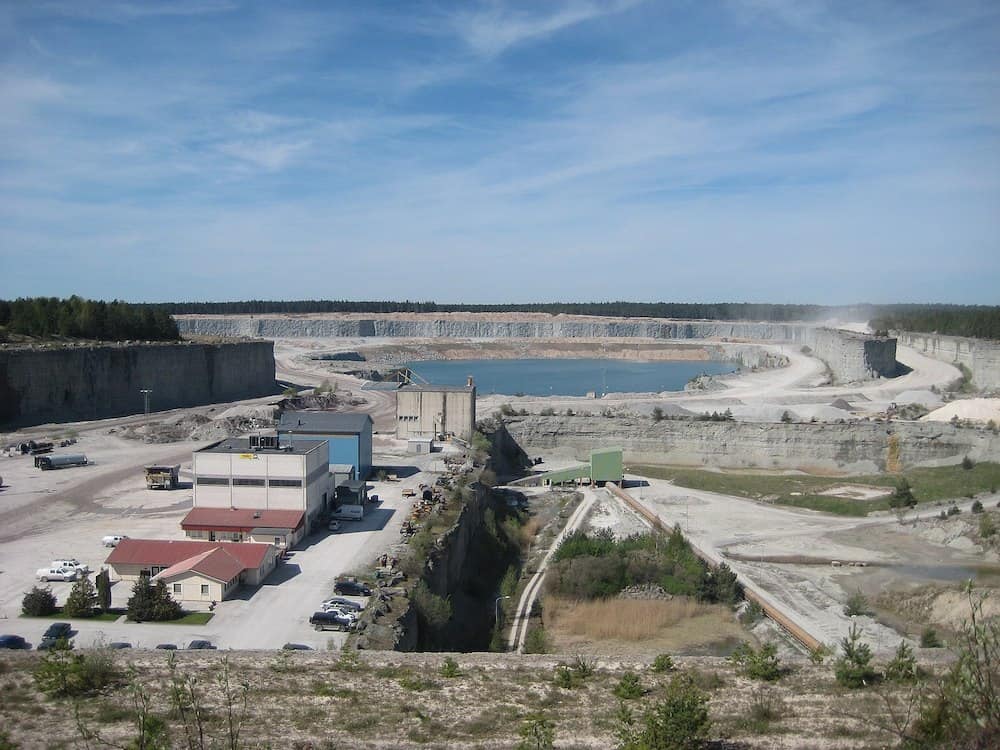
[Image above] The Slite cement quarry in Gotland, Sweden. Swedish company Cementa planned to upgrade the site to reduce CO2 emissions, but a recent Supreme Land and Environmental Court decision may shutter the plant instead. Credit: Calistemon, Wikimedia (CC BY-SA 4.0)
Despite concrete being the most consumed building material in the world—and second most consumed material overall, after water—the global construction industry currently is experiencing a cement shortage due to the COVID-19 pandemic.
Countries ranging from Jamaica, Georgia, the United States, and the United Kingdom are dealing with the shortage, which is driven by numerous factors including pent-up demand from infrastructure projects and limited production of raw materials due to restrictions put in place during the pandemic.
In Sweden, a recent decision by the Swedish Supreme Land and Environmental Court may complicate the country’s cement production further in the coming months and years.
Environmental court shuts down cement factory
Swedish company Cementa is the sole producer of cement in Sweden, and it has plants in Slite and Skövde. The company is a subsidiary of the Germany-based HeidelbergCement Group, one of the largest building materials companies in the world.
In early July, the Swedish Supreme Land and Environmental Court rejected Cementa’s application to renew its permit to mine limestone at the company’s existing quarries in Slite, Gotland.
Cementa originally received clearance from a lower court in January 2020 to renew its mining operations at the Slite site until 2041, but the clearance was challenged. The Supreme Land and Environmental Court based the recent decision on the grounds that there is insufficient evidence to assess the environmental impact of the site.
According to a Dezeen article, the Slite plant produces about three-quarters of all the cement used in Sweden. “It is also the second-largest source of greenhouse gas emissions in the country, responsible for three per cent of all CO2 emissions,” the article continues.
Cementa says the decision would jeopardize construction projects throughout Sweden—including, ironically, a plan to upgrade the Slite plant to capture and store CO2 emissions.
HeidelbergCement has pursued carbon reduction projects through some of its other subsidiaries, including one in Norway that we covered on CTT in May 2020. According to a Dezeen article, the proposed upgrade at Slite would capture and store up to 1.8 million tonnes of CO2 per year.
The original plan was to complete the upgrade by 2030. However, “The situation in Sweden could at least challenge or postpone the CCS [carbon capture and storage] project at Slite,” says Per Brevik, director of alternative fuels at HeidelbergCement, in the Dezeen article.
The Supreme Land and Environmental Court decision does not occur in a vacuum. In 2017, Sweden passed legislation that legally binds the country to reach net-zero emissions by the year 2045, five years earlier than previously planned. Learn more about Sweden’s climate policy framework, which contains climate goals and plans for a climate policy council, at this link.
Even earlier, in 2015, Sweden launched an initiative called Fossil Free Sweden (Fossilfritt Sverige) to drive work on reducing emissions. A YouTube channel for the initiative features several videos on their goals for various sectors, such as the video below on the construction and civil engineering sector.

Credit: Fossilfritt Sverige, YouTube
Author
Lisa McDonald
CTT Categories
- Cement
- Market Insights

